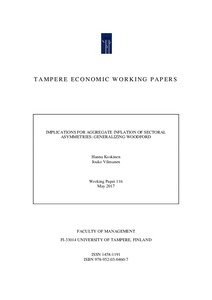Implications for aggregate inflation of sectoral asymmetries: Generalizing Woodford
Hannu Koskinen; Jouko Vilmunen
https://urn.fi/URN:NBN:fi-fe2021042823804
Tiivistelmä
This paper develops and simulates a simple two sector DSGE model for studying aggregate inflation and output dynamics under sectoral adjustment asymmetries. The CES aggregate consumption bundle consists
of two different groups of goods with imperfect substitutability between as well as within the groups. Allowing for different within group CES aggregators implies that the degree of substitutability between goods in a group is group-specific.
To generate sector-specific price rigidities the model assumes sector-specific Calvo pricing. The paper focuses on potential post-shock divergences across sectors as well as on the implications for aggregate inflation and output of the sectoral asymmetries and identifies an important role for the sectoral
relative price for aggregate dynamics. More specifically, the paper generalizes Woodford (2003), which only allows for the price rigidity to differ across sectors. Incorporating sector-specific price elasticities is
important and well in line with the micro-level evidence on individual as well as sectoral prices. From the point of view of allocational efficiency and welfare, relative price movements occupy a central role in models incorporating Calvo pricing. This particular feature underscores the perceived macroeconomic benefits of low and stable inflation. This paper takes this logic a step further by incorporating movements both in individual and sectoral relative prices.
Kokoelmat
- Rinnakkaistallenteet [27094]
